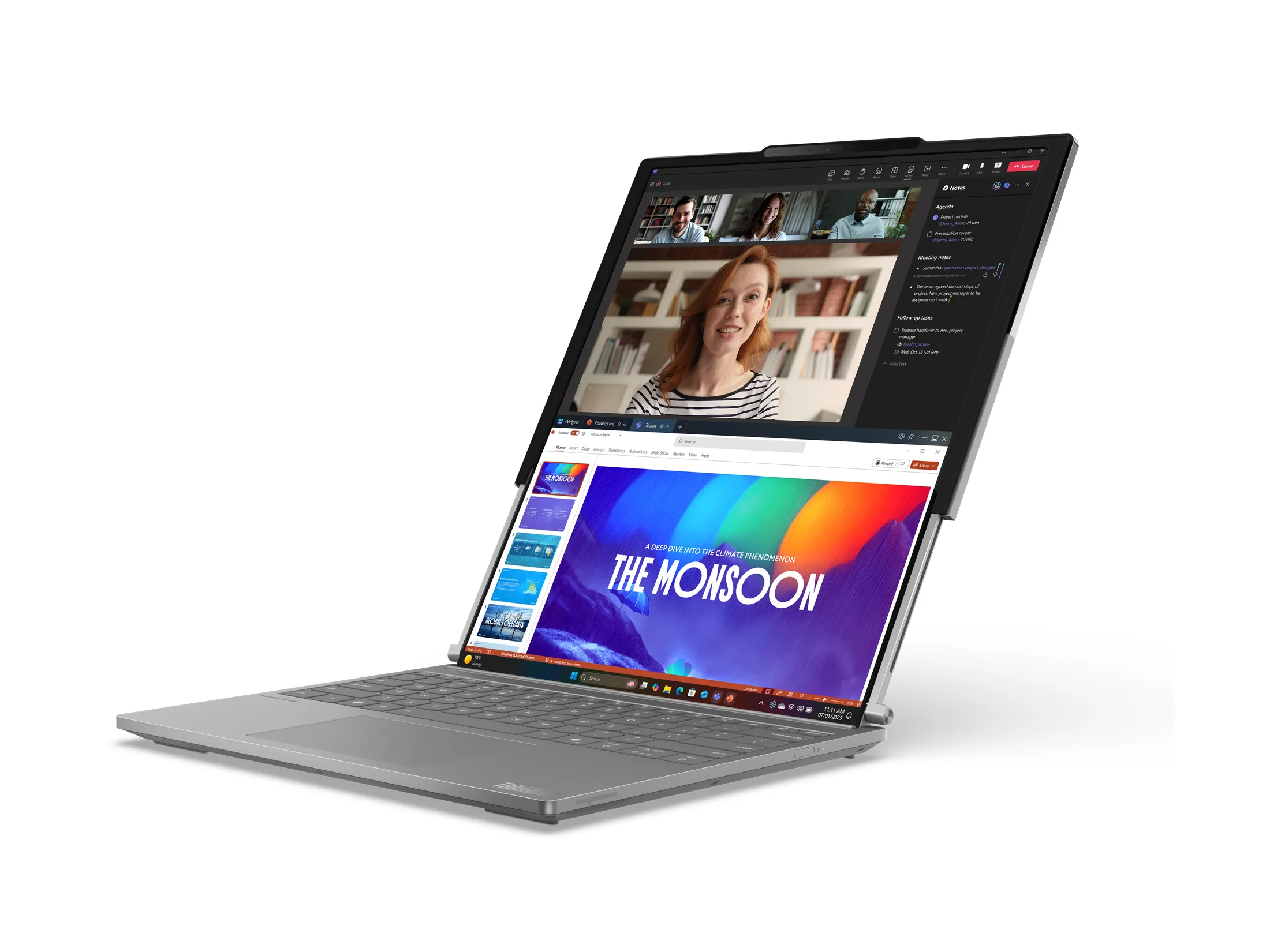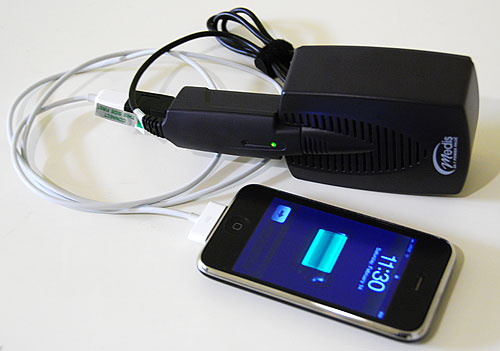
By Evan Ackerman
We’ve heard it all before: fuel cells are going to power the devices of the future. They’re going to put out more power for longer and be instantly rechargeable with disposable cartridges. Sounds great… But obviously, this hasn’t happened yet. At CTIA last year, though, we were introduced to a company called Medis, who is producing a portable fuel cell charger that you can actually buy right now. It’s between 25 and 40 bucks on Amazon, and we’ll let you know whether this new technology is worth the money in our review, after the jump.
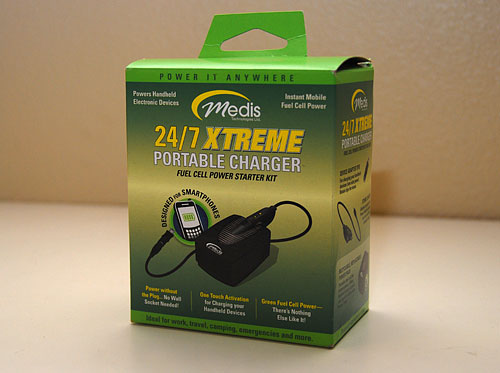
-How It Works
The Medis Xtreme is an honest-to-goodness fuel cell charger. The cartridge contains a mixture of alcohol, sodium borohydride, and alkaline, all stuff which isn’t going to murder the environment (not that you should try to eat it). When the fuel cell is activated, these chemicals combine with the air to generate electricity. Compared to other fuel cells, the Medis technology is a lot less complicated, with a self regulating reaction that makes power without a bunch of electronics or filters or membranes. This makes it cheap, which is good.
Since Medis ships their fuel cells unactivated in a sealed plastic bag, it can sit on the shelf (or in your house) for up to 18 months without losing any charging potential. Once the fuel cell is activated, you’ll need to use it within about 3 months before the cell depletes itself. Once the fuel is consumed, the fuel cell is reduced to nothing more than a plastic case containing some borates, all of which can be recycled.
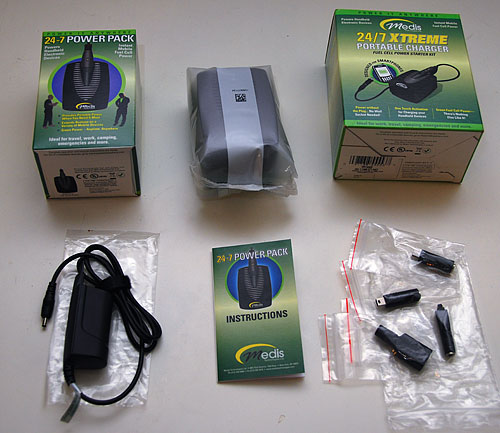
-What You Get
Medis sent me a “24/7 Xtreme Portable Charger Fuel Cell Power Starter Kit,” which includes a fuel cell cartridge, four adapter tips (USB, mini-USB, Treo, and Nokia) in separate plastic bags in a separate plastic bag, a power cable with a growth on one end that I assume is some kind of converter or regulator, and some instructions. More adapter tips for other devices are also available.
The cartridge itself is sealed in plastic, and comes in its own little pre-addressed box, which (if you open it carefully), can be resealed so that you can mail the fuel cell back to Medis for recycling after you’ve used it up. It’s not prepaid, but it’s a nice environmentally conscious touch. Medis will recycle the plastic directly, and the remaining borates inside get turned into laundry detergent or fire retardant or, um, cosmetics.
-Using It
The fuel cell arrives sealed in plastic and unactivated. To activate it, you peel off a strip around the base, and then squeeze the top and bottom of the cell together to release the fuel:

It takes a significant amount of force to do this; I had to use both of my weak-ass hands to get it to work. I makes all kinds of crunching, squishing, whooshing noises when you do it, and there’s a solidly satisfying CLICK when you push it together all the way. After a little shaking (it’s very sloshy sounding) and a few gentle taps on a hard surface to make sure the fuel is distributed in the cell, a green light comes on on the power cable, and it’s ready to go.
Charging a device is simple… Plug the power cable into the cell, plug your device into the appropriate adapter at the other end, and off you go. The only weird thing is that Medis advises you to place the fuel cell on its side (or upright) for best results, even though the sides are curved and the bottom is flat with feet things on it.
At the moment, you can only recharge one device at once, but Medis has a triple splitter tip just about ready to go. Oh, and on a side note, you’re allowed to take up to three fuel cells on airplanes.
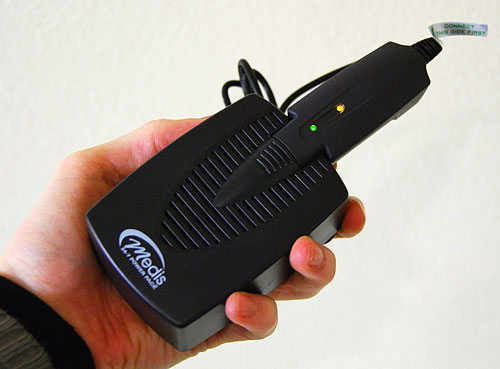
-Does It Work?
It took about 30 seconds for the fuel cell to get going after it was activated. I’d say that’s “instant” for all practical purposes. The Xtreme was able to charge my iPhone at about the same rate as I get from plugging it into a wall adapter. You’re only supposed to charge things for a few hours at a time in order to get the maximum lifetime out of the fuel cell, but that should be enough to top off most devices. Also, Medis recommends not using the power pack to recharge things from dead, since it’s less efficient that way.
Medis says that you can get up to 30 hours talk time or 60-80 hours of audio playback on something like an iPod from a single power pack. That sort of claim is hard to test, and it’s not how most people use their devices. I tested the Xtreme under what I consider normal use, which is to say, I used it as a replacement for a wall outlet to charge my iPhone… At the end of the day, my iPhone is usually about 1/4 charge (sometimes less), and I plugged it into the fuel cell in the evening, unplugging it after the phone was fully charged. This worked great for four days, charged most of the way on the fifth (to 90%ish), and then that was it. Medis estimates that the average smartphone can get up to six charges, so this seems about right.
-Overall Impressions
Well, it’s a fuel cell, which is really cool. It’s got shelf life that beats many other emergency power solutions, and unlike battery packs, it’s ready to go instantly, you don’t have to worry about trickle charging it. It’s also lighter than most battery packs, and in some ways it’s substantially more environmentally friendly, especially with its integrated recycling program. It’s dead simple to use, works quickly and works well, and is ideal for situations where electricity simply isn’t available, like camping, or in emergencies.
There are certainly some downsides, though. Firstly, it’s big. It’s not huge, and it doesn’t weigh that much, but it won’t fit comfortably in your pocket. Although it does have a long shelf life, it also has an expiration date… My guess is that it starts to degrade after 18 months as opposed to just going dead, but still, if you buy it for an emergency, you’d better hope something bad happens within a year and a half or you might not get the performance you paid for. For a “disposable” power solution, it’s also a little on the expensive side, at $25 per single-use cartridge.
Overall, the Medis Xtreme is a good solution for charging your gadgets, and in certain situations, it might even be an ideal solution. For day to day backup power, I might recommend a small USB battery pack (there a tons of options out there) that might only be able to recharge your cellphone once, but it’ll be small and you can recharge it over and over for free. But for those times when you’re actually going to be off the grid for an extended period (whether intentionally or not), the Medis Xtreme fuel cell charger could be just what you need.
You can find the Medis Xtreme charger at some Best Buy stores, and on Amazon.com. The starter kit costs $40, and replacement cartridges are $25 each. An emergency kit that includes a really freakin’ bright flashlight that’s powered directly from the cell is also available for $50:
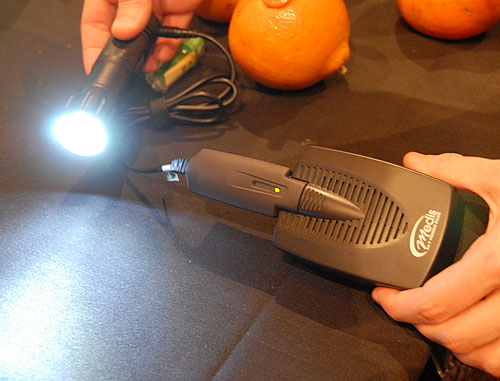
Oranges sold separately.










